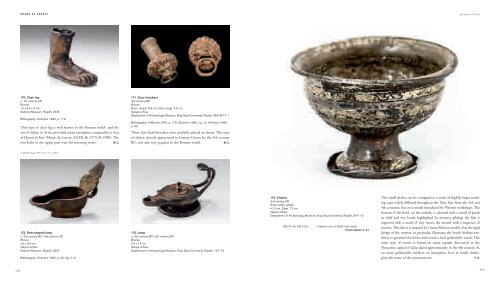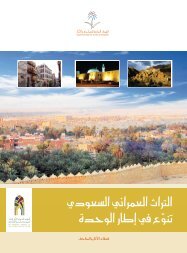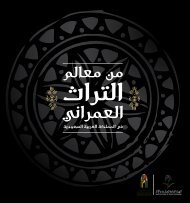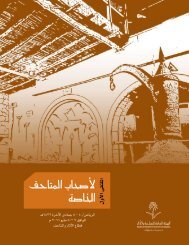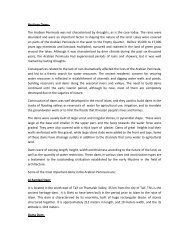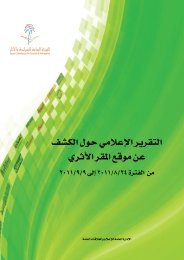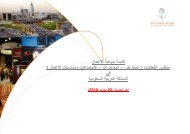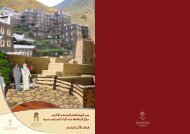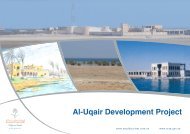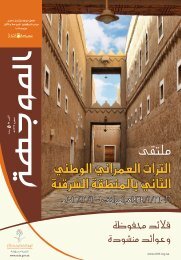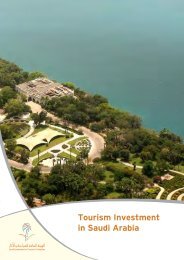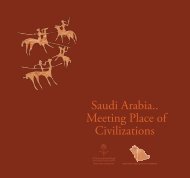Roads of Arabia
Roads of Arabia
Roads of Arabia
You also want an ePaper? Increase the reach of your titles
YUMPU automatically turns print PDFs into web optimized ePapers that Google loves.
18bis Arabie US p318-363.qxd 23/06/10 22:13 Page 344<br />
ROADS OF ARABIA<br />
Qaryat al-Faw<br />
170. Chair leg<br />
c. 1st century AD<br />
Bronze<br />
10 x 8.5 x 4 cm<br />
National Museum, Riyadh, 2235<br />
Bibliography: Al-Ansari 1982, p. 112.<br />
This type <strong>of</strong> chair leg is well known in the Roman world 1 and the<br />
site <strong>of</strong> Sidon, in Syria, provided many exemplars comparable to that<br />
<strong>of</strong> Qaryat al-Faw (Musée du Louvre, AGER, Br 2579, Br 2580). The<br />
two holes in the upper part were for inserting rivets. M. C.<br />
171. Door knockers<br />
3rd century BC<br />
Bronze<br />
Diam. (head): 8.8 cm; Diam (ring): 4.5 cm<br />
Qaryat al-Faw<br />
Department <strong>of</strong> Archaeology Museum, King Saud University, Riyadh, 346/347 F 1<br />
Bibliography: Al-Rachid 1975, p. 173; Ghoneim 1980, fig. 13; Al-Ansari 1982,<br />
p. 93.<br />
These lion-head knockers were probably placed on doors. This type<br />
<strong>of</strong> object, already appreciated in Eastern Greece by the 5th century<br />
BC, was also very popular in the Roman world. M. C.<br />
1. Boube-Piccot 1975, pl. 177, p. 243.<br />
172. Pear-shaped lamp<br />
c. 3rd century BC–3rd century AD<br />
Bronze<br />
3.5 x 9.5 cm<br />
Qaryat al-Faw<br />
National Museum, Riyadh, 2237<br />
Bibliography: Al-Ansari 1982, p. 92, figs 1–2.<br />
173. Lamp<br />
c. 3rd century BC–3rd century AD<br />
Bronze<br />
2.5 x 14 cm<br />
Qaryat al-Faw<br />
Department <strong>of</strong> Archaeology Museum, King Saud University, Riyadh, 15 F 13<br />
174. Chalice<br />
3rd century AD<br />
Silver, partly gilded<br />
H. 5 cm; Diam. 7.7 cm<br />
Qaryat al-Faw<br />
Department <strong>of</strong> Archaeology Museum, King Saud University, Riyadh, 34 F 16<br />
(Qs 3 )m bn Mlk s 2 ym<br />
(Qasim) son <strong>of</strong> Malik had made<br />
(transcription C. R.)<br />
This small chalice can be compared to a series <strong>of</strong> slightly larger standing<br />
cups widely diffused throughout the Near East from the 3rd and<br />
4th centuries, but on a model introduced by Western workshops. The<br />
bottom <strong>of</strong> the bowl, on the outside, is adorned with a motif <strong>of</strong> petals<br />
in relief and two bands highlighted by mercury gilding: the first is<br />
engraved with a motif <strong>of</strong> tiny waves, the second with a sequence <strong>of</strong><br />
rosettes. This décor is inspired by Graeco-Roman models, but the rigid<br />
design <strong>of</strong> the rosettes, in particular, illustrates the South <strong>Arabia</strong>n tendency<br />
to geometricize forms and reveals a local goldsmith’s touch. This<br />
same type <strong>of</strong> rosette is found on some capitals discovered in the<br />
Himyarite capital <strong>of</strong> Zafar dated approximately to the 4th century. As<br />
on many goldsmith’s artefacts, an inscription, here in South Arabic,<br />
gives the name <strong>of</strong> the commissioner. F. D.<br />
344<br />
345


